
The Sahara desert is the third-largest desert in the world (after the Arctic and Antarctic) and the largest hot desert in the world. It stretches across 3.6 million square miles making its size comparable to that of the entire United States (which spans across 3.8 million miles). The name Sahara itself literally translates to “the Greatest Desert”. This desert is known for its warm and dry climates, which restricts cloud formation and makes rainfall extremely scarce. The grounds are laden with endless mounds of sand seemingly designed to scald the feet while sources of water are few and far between.
While humans dwell in cities and villages to protect themselves from the elements, natural selection in animals works slightly differently. These 10 animals reside in the Sahara desert and have developed unique features that make them adapt and thrive in an environment so hostile no living thing should be able to.
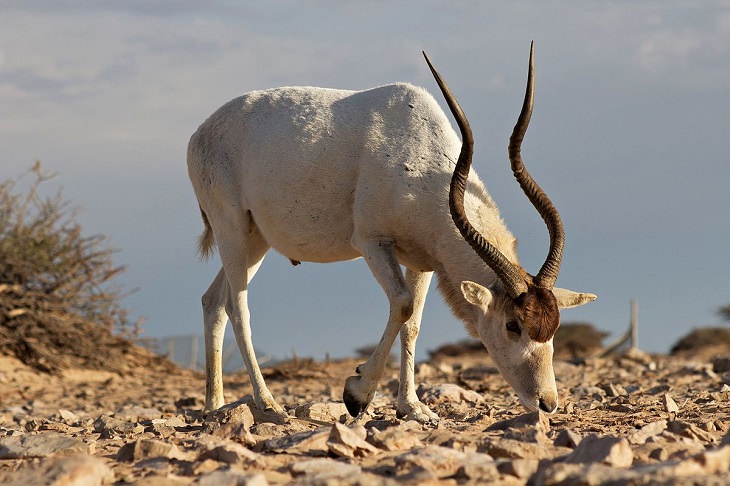
(By Haytem93, Wikimedia Commons)
The Addax Antelope is an endangered species and possibly the antelope species most well-adapted for surviving in the desert. They feed exclusively on grass, roots and plant parts, and can be identified by their short legs, wide hooves and the stunning twisted horns on their heads.
These antelopes are only active during the cooler hours of the day, early in the mornings and evenings. This is to avoid moving around in search of food or water in the hotter parts of the day, the latter of which is easier to find during the cool hours.
The color of their coats changes with the seasons, turning white in the summer to reflect the Sun’s hot rays and gray in the winter to keep their bodies warm. This allows them to effectively stabilize their body temperature. Their hooves are wide and flat to enable them to walk easily on the hot sand.
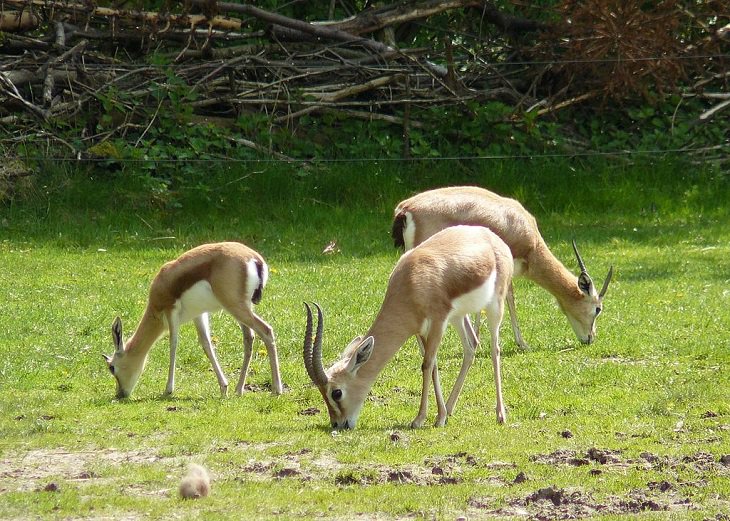
(By Altaipanther, Wikimedia Commons)
This galloping gazelle is a small and endangered species of antelope that is well-adjusted to life in the desert and can be found all across the Sahara. Their primary diet consists of carefully selected plants, high in moisture content, with a preference towards pods of the Acacia tree.
The moisture absorbed by consuming these plants is enough to sustain these long-legged creatures for long periods of time without water. They can also tolerate extreme levels of heat. Much like the Addax antelope, these gazelles choose to be active in the early mornings and evenings, though only during the hot summer season.
Their movements are also determined by the predators they encounter. To avoid human hunters spotted nearby, they often choose to move at night. They can run up to 50 miles per hour and make tall leaps to escape any threats.
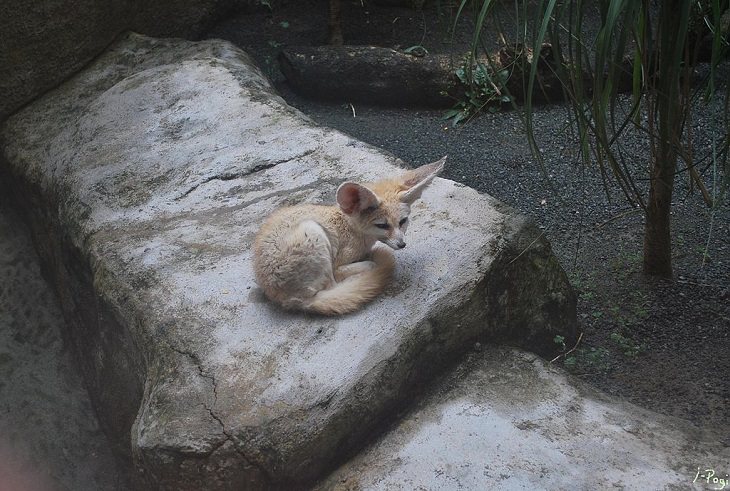
(By Jpogi, Wikimedia Commons)
This adorable little fox, the smallest of its kind, grows approximately a foot long at most and weighs no more than 2-3 pounds. It resides in the drier regions of the Sahara desert and can be easily identified by its long ears that grow up to 6 inches in length.
These long ears are an adaptation to help them survive in the harsh conditions. Using their ears, fennec foxes hear predators and other threats nearby, keeping them alert and wary of oncoming danger. Their ears also help by expelling excess heat from their bodies, allowing them to remain cool even on hotter days.
Their kidneys are adapted to survive long stretches without water and, like the Dorcas gazelle, they can survive on the moisture of their food. Their beautiful thick sand-colored fur can be found even on their paws, making it easier to walk on the hot sand, as well as stay insulated from both heat and cold.
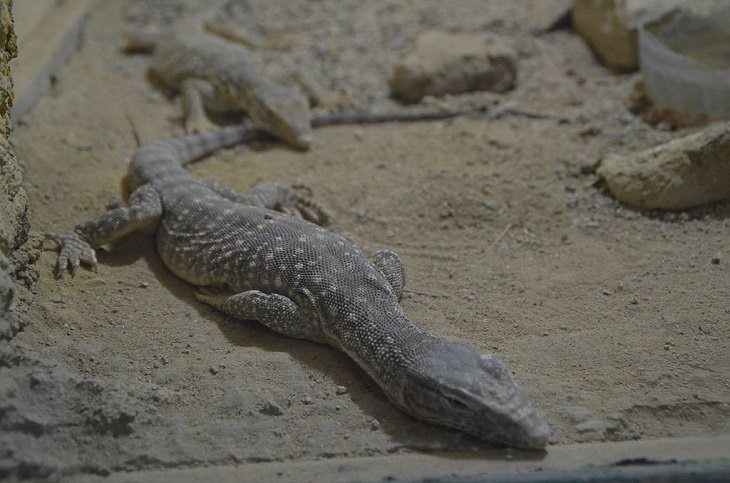
(By Hatem Moushir, Wikimedia Commons)
This massive lizard can also be found in the Arabian desert and drier regions of Central Asia, as well as the Sahara desert. These creatures are perfectly suited for desert conditions and their skin allows them to thrive in the heat. They prey on insects, birds and small mammals, and hibernate during winter to conserve energy.
Unlike the desert-dwelling antelopes, desert monitors are active during the days and can easily endure the heat. They are equipped with salt glands that retain moisture well, allowing them to survive without water for long periods of time.
Desert monitors are incredible predators, moving through the heat and sand across great distances at a rapid speed of 20 miles per hour. They share a common feature with snakes, i.e., a forked tongue, which allows them to sense chemicals in the air to detect their prey.
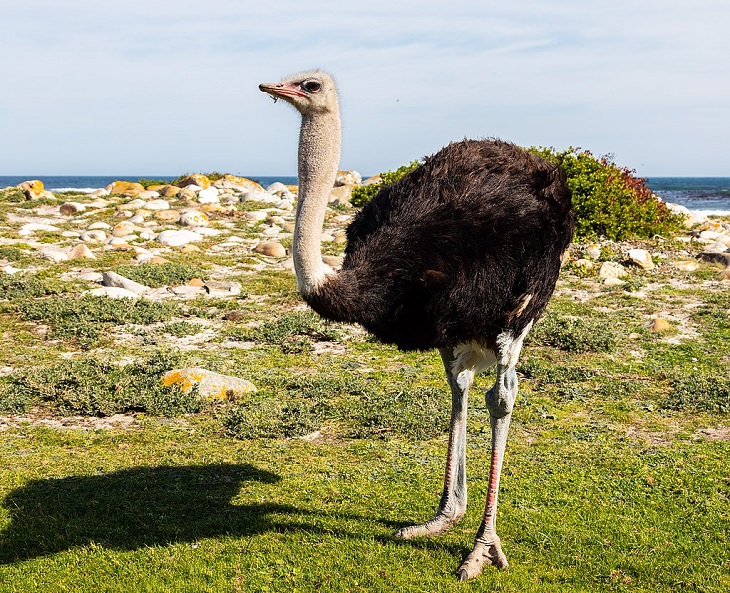
(By Diego Delso, Wikimedia Commons)
Ostriches can be found in savannas across desert regions of West Africa and Central Africa. Growing upwards of 8 feet and up to 250 pounds, they are the largest and heaviest bird in the world. Their diet consists largely of insects, rodents, and lizards in addition to certain plants.
They have two-toed feet, which makes traveling across heavy sand dunes easier. Their water needs are minimal, as they retain most of the moisture from the plants they consume. This also allows them to survive even in the hottest temperatures.
As a flightless bird, they are often preyed upon by other carnivorous desert-dwellers like the Golden Jackal (No.7 on this list). Their long necks aid them in detecting oncoming predators from a distance. They also have immensely strong long legs that allow them to move up to 45 miles per hour, outrunning predators or wield powerful defensive kicks.
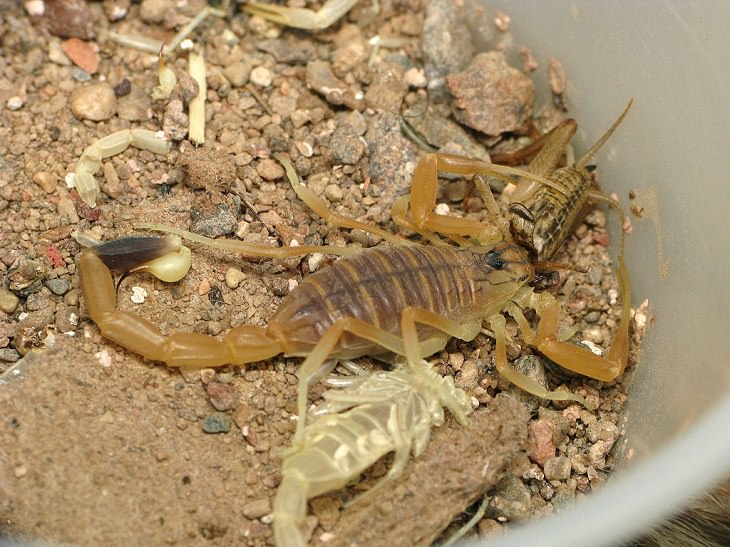
(By Anatolii Kokoza, Wikimedia Commons)
This ominously named arachnid is a formidable beast indeed and lives in hot deserts like the Sahara along with scrublands in the Middle East and North Africa. Their sting is extremely painful, and their venom, while not lethal to the healthy adult human, can cause paralysis. These scorpions feed on insects, spiders, small animals like mice and even other scorpions.
Their small size allows them to hide from the heat under small rocks and in small cracks and burrows. They come out only at night to hunt. These scorpions require water on a semi-regular basis, but can largely survive on water absorbed through their food.
This brings us to one especially unique feature these creatures have adapted to survive in the desert. They have a self-regulating metabolism, so in parts of the desert where food is scarce, the scorpion's metabolism adjusts to survive as long as a year with minimal food. Food consumed by this scorpion plays a big role in hydration.
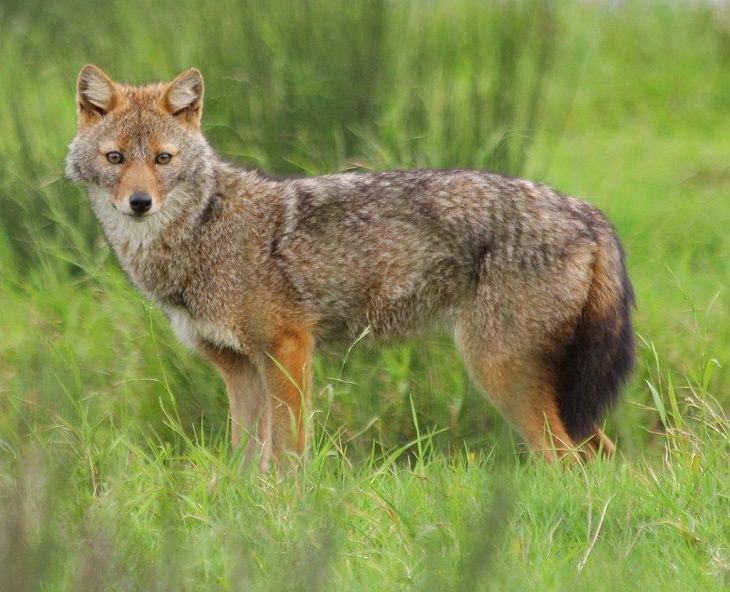
(By Prabukumar84, Wikimedia Commons)
The Golden Jackal is a member of the canine family, and the member best suited for desert conditions. The golden jackal is the largest species of jackal, growing between 2 and 3 feet in length and weighing upwards of 25 pounds. They enjoy an extremely varied diet, consisting of animals like gazelles, rodents, reptiles, birds, eggs and even fruits.
Their versatile fur allows them to survive in a multitude of different habitats, taking on lighter colors in the summer and darker colors in the winter, thereby stabilizing body heat, like other fur-laden desert-dwelling animals. This species is highly tolerant of hot and dry conditions.
As an omnivorous animal, its diet retains enough water for sustenance in dry Saharan climates as well as nutrients for other habitats with harsh conditions. This Jackal greatly resembles a small wolf, and much like wolves, it has a keen sense of hearing and smell. The golden jackal also has night vision making both prey and other predators easy to spot.
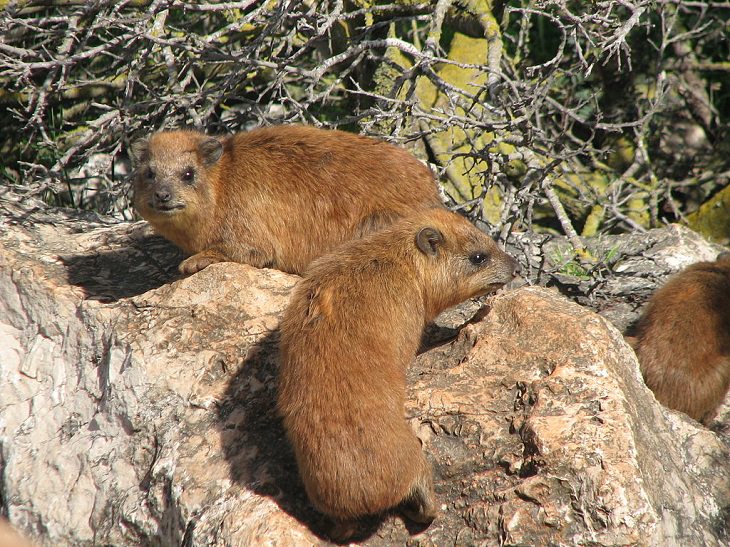
(By Arikk, Wikimedia Commons)
The hyrax, also known as the rock hyrax, the Cape hyrax, and the rock rabbit is a small to medium mammal indigenous to Africa and common in the Sahara desert. These creatures are herbivorous, feeding on grass, leaves, and fruits. The moisture from their food can allow them to sustain themselves without water for over a week.
They are stout, round-eared creatures with short bristles of fur that changes color in accordance with the temperature and season. However, aside from their fur, their natural thermo-regulation abilities are limited. Like the antelopes, hyraxes forage for food only in the early morning hours and evenings.
As they are prey to numerous larger species like wild cats and snakes, this species has a strong pack mentality. They live in colonies, avoid movement in the night and assign dominant males to stand guard and act as the first line of defense for the colony against predators.
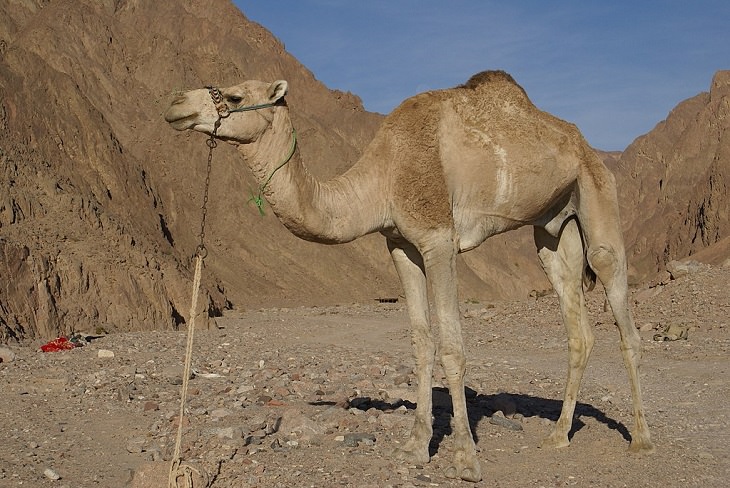
(By Florian Prischl, Wikimedia Commons)
The dromedary camel is the single-humped camel, and a fixed figure in all desert-related adventures (both real and fictional). These camels normally feed on weeds and shrubs. They can also drink upwards of 40 liters of water in less than 15 minutes. However, their humps play a significant role in their survival in the desert, as they are designed to store up to 80 pounds of fat.
In cases of food scarcity in the desert, their bodies instinctively break down the fat in the hump to provide the body water and energy. In this manner, these camels can remain hydrated for an extended period. Their bodies are also designed not to sweat even in extremely high temperatures, which assists the camel in retaining water and preventing any loss of moisture.
To aid them in movement, camels have long legs with large feet perfect for walking across great distances in the sand. Their knees have naturally grown leathery patches to prevent burns when resting in the sand on their knees. They also have long eyelashes that protect their eyes from blowing sand.
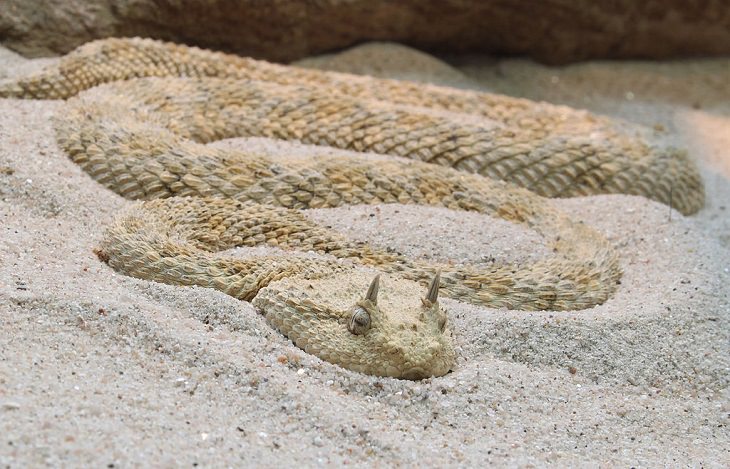
(By H. Krisp, Wikimedia Commons)
A deadly desert snake, the Horned Viper is a large and heavy venomous serpent that grows up to 2 feet in length. They are found in the Sahara desert as well as deserts in the middle east. Their venom contains over 13 different toxins, and they enjoy a steady diet of rodents, insects, and birds.
They are identifiable by the horns above both eyes of the serpent. The color of the Horned viper is a pale brown shade, resembling the grainy desert sand. This, along with their agile sideways movements, allows them to blend into their surroundings. On hot days, they can bury themselves in the sand, with only their nostrils exposed, to insulate from the heat.
This technique of burying themselves also aids in their predatory activities. Preferring to hunt at night, their ability to camouflage effortlessly allows them to ambush mice and other rodents they prey on, as well as avoid other predators in the vicinity.